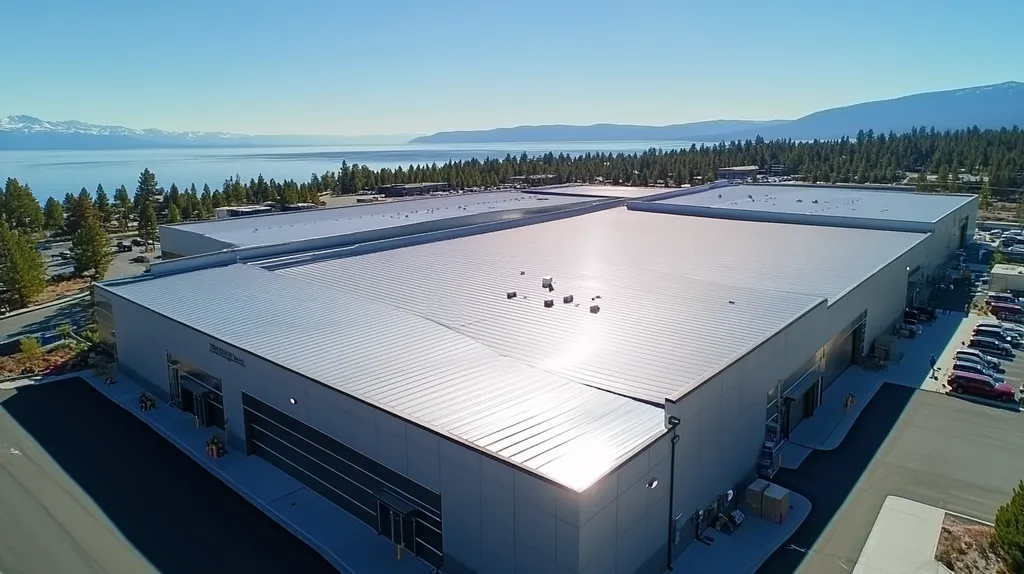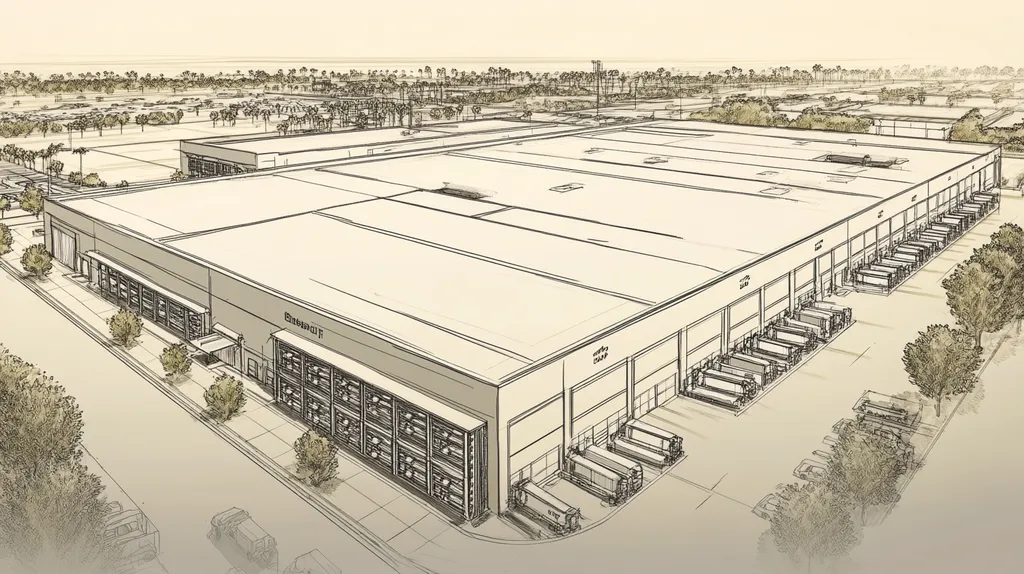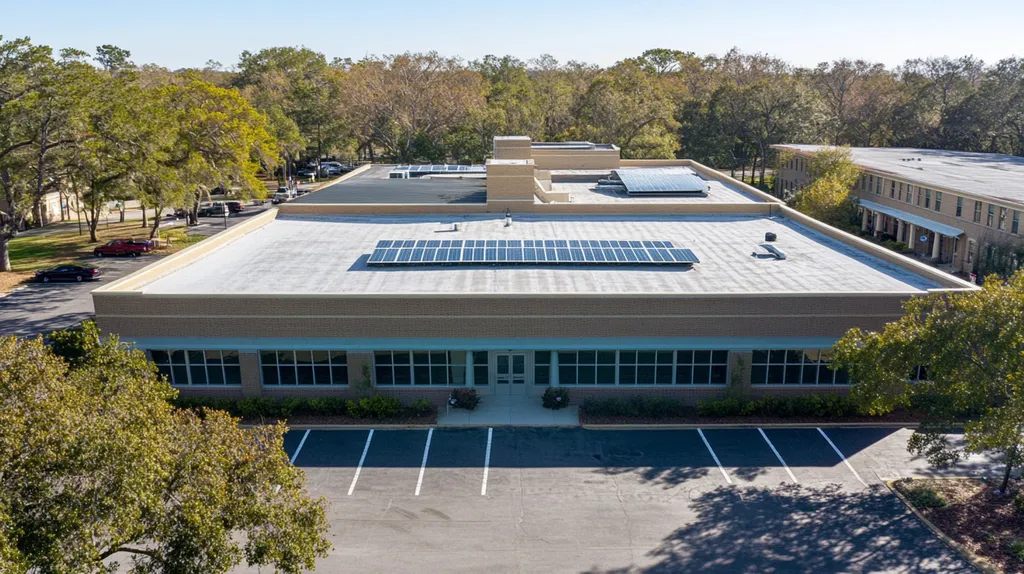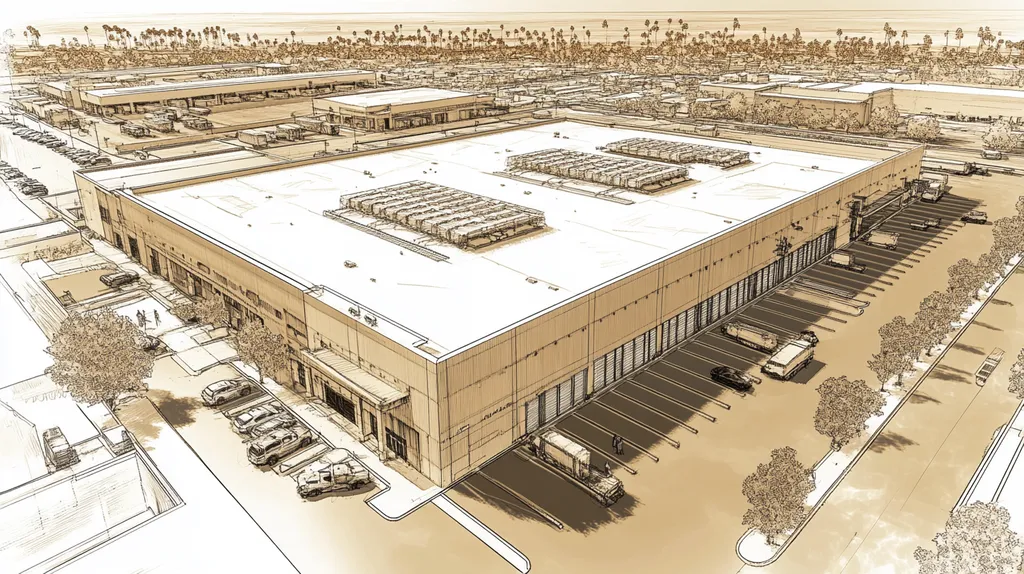Every year, over 50,000 commercial structure fires claim lives and destroy billions in property value, with 21% originating from roofing-related issues. For property owners and facility managers, understanding fire safety assessments isn’t just about compliance—it’s about survival.
The complexity of modern roofing systems, combined with evolving building codes and safety standards, creates significant challenges in fire safety evaluation.
This comprehensive guide examines crucial aspects of commercial roof fire safety, from common misconceptions about ratings and materials to evidence-based testing protocols that can mean the difference between minor damage and catastrophic loss.
SECTION 1: COMMON MISCONCEPTIONS
Misunderstandings about fire safety in commercial roofing pose serious risks. Alarmingly, over 50,000 commercial structure fires ignite annually in the U.S., resulting in devastating property damage and endangering lives. For property owners and facility managers, a clear understanding of fire safety assessments is crucial. This section aims to clarify common misconceptions surrounding class ratings, the difference between fire resistance and fire retardancy, and the often-overlooked significance of underdeck components.
Class Ratings and Their Meanings
Many people mistakenly assume that a higher class rating automatically translates to a completely fireproof roof. Class A, B, and C ratings reflect varying levels of fire resistance but do not provide a definitive guarantee of safety. For instance, while a Class A rating signifies the highest level of fire resistance, it doesn’t completely eliminate the risk of ignition from extreme heat or flames.
It’s essential to recognize that local building codes dictate the required class rating for roofing systems. Compliance with these codes is important, but understanding what these ratings mean in terms of actual performance during a fire is equally critical. Overlooking this can lead property owners to erroneously believe that class ratings ensure total fire protection, which is a dangerous assumption.
Additionally, the materials used in construction and ongoing maintenance practices can affect the effectiveness of these ratings over time. Regular assessments are vital to ensure that materials still meet their original class ratings and adhere to safety standards.
Misinterpreting class ratings can expose property owners to significant risks. Such misunderstandings heighten the chances of catastrophic damage in the event of a fire, jeopardizing both lives and investments.
Fire Resistance vs. Fire Retardancy
A critical area of confusion lies between fire resistance and fire retardancy. Fire-resistant materials are designed to withstand heat and flames for a specific period, while fire-retardant materials are treated to prevent ignition. Grasping this distinction is essential for facility managers when selecting roofing materials.
In practical terms, fire resistance can buy valuable time during a fire, allowing for safe evacuations and firefighting efforts. On the other hand, fire retardancy can inhibit the rapid spread of flames, adding an extra layer of protection. Unfortunately, many property owners conflate these terms, leading to potentially inadequate safety measures.
For example, a property might install a fire-retardant roof coating but mistakenly rely solely on that coating for safety. Without an understanding of the underlying fire-resistant materials, owners may create a false sense of security. Proper training and guidance regarding the use of both material types can help reduce this risk.
Yearly, countless commercial properties suffer significant financial losses due to misunderstandings surrounding fire safety materials. Addressing these misconceptions can result in enhanced safety measures and better preparedness for fire emergencies.
Ignoring Underdeck Components
Many property owners underestimate the importance of underdeck components in their fire safety assessments. The underdeck consists of insulation, framing, and other materials that can facilitate the spread of fire if they aren’t properly rated or maintained. This oversight can significantly heighten a building’s susceptibility to fire hazards.
For instance, if the insulation lacks a fire rating, it may ignite easily and contribute to a fire’s escalation—turning a seemingly minor issue into a full-blown disaster. Property owners must remember that fire protection is not confined to just the rooftop; it encompasses the entire roofing system.
Conducting comprehensive assessments of all elements, including underdeck components, provides a complete picture of a roof’s fire safety. Regular inspections can uncover hidden vulnerabilities, allowing for informed strategies to mitigate risks.
Neglecting underdeck components can jeopardize the effectiveness of the entire roofing system at critical times. Ensuring that every aspect meets fire safety standards is imperative for protecting lives and property.
SECTION 2: PRACTICAL IMPLICATIONS
Fire safety assessments of commercial roofs have moved from being a mere recommendation to an absolute necessity. Ignoring fire safety can lead to dire consequences, including injuries, property damage, and potential loss of life. Alarmingly, 21% of commercial building fires start because of roofing materials and systems. Understanding the practical implications of fire safety assessments empowers property owners to navigate complex building codes, ensure occupant safety, and effectively manage insurance liabilities.
Impact on Building Codes and Regulations
Building codes related to fire safety are continually evolving, designed to address emerging threats. To remain compliant, property owners must keep abreast of these updates. For instance, the International Building Code specifies required fire-resistant materials for roofing in areas deemed high-risk.
Noncompliance can lead to hefty fines and project delays. Buildings failing to meet these standards may struggle to obtain occupancy permits. By conducting fire safety assessments, property owners can pinpoint areas needing improvement before they escalate into significant compliance issues.
Moreover, as local regulations tighten, older roofing systems may need upgrades or full replacements to comply with new standards. Taking a proactive stance on fire safety can prevent costly penalties and enhance overall safety for occupants.
In summary, routine fire safety assessments are crucial for ensuring compliance with changing building codes, protecting both the property and its financial investment.
Effects on Occupant and Property Safety
The safety of all building occupants is of utmost importance in any commercial space. Roofs that fail fire safety assessments can create dangerous conditions, such as the rapid spread of fire. By integrating compliant roofing systems, property owners can significantly reduce the likelihood of fire-related injuries or fatalities.
For example, choosing Class A fire-rated roofing materials can considerably slow the spread of flames, giving occupants crucial time for safe evacuation. This is essential in busy commercial environments where every second counts.
Additionally, enhancing fire safety not only protects lives but also safeguards buildings. By decreasing fire risks, properties are less prone to severe damage, which can lead to expensive repairs and costly interruptions to business operations. Fire safety assessments identify vulnerabilities, allowing for a fortified approach to both life and property protection.
Ultimately, adopting a rigorous fire safety strategy can bolster a business’s reputation, demonstrating a commitment to the well-being of its occupants.
Consequences for Insurance and Compliance
Insurance providers are increasingly evaluating fire safety practices before issuing policies. A history of poor fire safety or outdated roofing may lead to higher premiums or, in some cases, denied coverage. Regular fire safety assessments offer vital documentation that can be essential during negotiations with insurance companies.
Additionally, well-documented assessments verify that property owners have taken necessary preventive measures, which can facilitate smoother claims processing if a fire occurs.
On the flip side, failure to comply with fire safety regulations can invite heightened scrutiny from regulatory authorities, possibly resulting in extensive audits or penalties. Being proactive about fire safety through assessments can significantly minimize these risks.
In conclusion, understanding the financial and operational implications of fire safety assessments is critical for commercial property managers aiming to protect their investments while maintaining compliance.
SECTION 3: COST OF MISINFORMATION
Misinformation about commercial roof fire safety comes with significant financial consequences. According to the National Fire Protection Association, businesses across the U.S. incur billions in losses every year due to fire-related events. Misunderstanding critical aspects like roof materials, fire resistance ratings, and maintenance routines can lead to catastrophic results. This section will delve into the financial ramifications of fire damage, the impact on insurance costs, and the hidden expenses of business interruptions resulting from inadequate fire safety assessments.
Financial Losses from Fire Damage
The financial toll of fire incidents can be staggering, affecting both the structure and its valuable contents. A seemingly minor fire can escalate rapidly if flammable materials are present, causing extensive property damage. The average commercial fire claim often exceeds hundreds of thousands of dollars, potentially wiping out a year’s worth of profits.
Additionally, businesses may lose critical equipment, inventory, and important documents, leading to operational disruption. Repair and replacement expenses can rise quickly, even from what appears to be a minor incident. Without robust fire safety measures in place, the costs associated with repairing roofs, walls, and electrical systems can be substantial.
Inadequate safety measures can also lead to state and local penalties due to failure to comply with building codes and regulations. Noncompliance can result in hefty fines, further straining financial resources.
The risks linked to insufficient fire safety assessments emphasize the need for accurate information and proactive measures. While investing in comprehensive evaluations may seem expensive initially, it can prevent devastating financial losses in the long run.
Increased Insurance Premiums
Insurance providers assess risk based on various factors, including fire safety measures. Properties that lack adequate fire protection—such as fire-rated roofing materials—typically face higher insurance premiums. A single fire incident can trigger significant increases, directly impacting a company’s financial health.
Moreover, businesses with a history of fire-related incidents often struggle to secure coverage at favorable terms. Insurance underwriters will scrutinize fire safety practices, and without clear documentation of safety measures, businesses may encounter denial of coverage or inflated premiums. This situation can drive overall operational expenses higher.
Misjudging fire risks can create a cycle of escalating costs. As insurance premiums rise, property owners may consider reducing their coverage to save money, ultimately leaving them exposed to more severe losses should a fire occur.
By understanding the fire safety landscape, property owners can make informed decisions. Proper documentation of fire resistance ratings can lead to better insurance terms, promoting long-term financial stability.
Business Interruption Costs
In addition to the direct costs of fire damage and rising insurance rates, businesses also incur interruption costs during recovery after a fire incident. Even minor fires can lead to extended downtime, disrupting productivity and revenue flows.
During the recovery process, companies may face challenges in fulfilling operational commitments. Staff may need to be reassigned to manage recovery logistics, causing drops in workforce morale and overall productivity. The longer a business is disrupted, the harder it becomes to return to pre-incident performance levels.
Research indicates that a substantial percentage of businesses suffering a major disruption may never fully recover, underscoring the crucial role of fire safety assessments. Proactive fire safety measures can help mitigate downtime and shield businesses from severe financial repercussions.
In conclusion, the costs associated with misinformation in roofing fire safety extend well beyond immediate fire damage. By understanding these financial implications, property owners and facility managers can make informed choices that protect their buildings and their businesses.
SECTION 4: REALITY CHECK
The fire safety of commercial roofs goes beyond mere compliance with codes; it is a critical aspect that can prevent catastrophic losses. Each year, an estimated $3 billion in fire damage occurs within commercial properties, much of which can be avoided through a solid understanding and adherence to established fire safety standards. This section delves into key industry standards, the vital functions of thermal barriers and fire-stopping systems, and the necessity of conducting regular roof inspections to ensure ongoing fire safety compliance.
Understanding ASTM E108 and NFPA Standards
Standards such as ASTM E108 and those from the National Fire Protection Association (NFPA) are fundamental in evaluating fire resistance for roofing materials. ASTM E108 tests roof coverings for their ability to endure fire exposure from external sources, while the NFPA offers extensive safety protocols aimed at both preventing and responding to fire hazards.
Ensuring compliance with these standards is essential for commercial roofing systems, as non-compliant roofs can allow flames to penetrate building structures, risking lives and property. By grasping the implications of these standards, property owners can better protect themselves and their occupants.
Regular adherence to and updates regarding these guidelines is vital for sustaining fire safety. Property owners should facilitate routine testing and evaluation of their roofing systems against these industry benchmarks. This foresight not only enhances safety but can also lead to substantial savings in potential liabilities.
Role of Thermal Barriers and Fire-Stopping
Thermal barriers and fire-stopping systems are integral to enhancing fire safety in commercial roofing. Thermal barriers serve to prevent heat transfer, thus helping to inhibit the spread of fire across rooftops, while fire-stopping materials effectively seal openings and joints, restricting the migration of fire and smoke within a building.
The strategic selection of thermal barriers can greatly diminish the likelihood of fire incidents. For example, using fire-rated insulation beneath roof membranes significantly strengthens resistance against flame propagation.
Without these protective systems, even a minor ignition source might escalate rapidly into a full-blown disaster. Property managers have a critical duty to ensure that thermal barriers and fire-stopping methods meet the latest standards.
Conducting routine evaluations of these systems can identify potential weaknesses before they escalate into serious hazards. Therefore, property owners should prioritize the regular review of these safety systems alongside ongoing maintenance efforts.
Importance of Regular Roof Inspections
Regular inspections are paramount for ensuring both fire safety and the overall integrity of roofing systems. Comprehensive assessments can reveal vulnerabilities, such as gaps in thermal barriers or deteriorating materials, which can elevate fire risks significantly.
Such evaluations should not only focus on material integrity but also on compliance with fire safety standards. Neglecting to perform regular inspections could leave unnoticed issues that transform into critical hazards over time.
For instance, roofing that displays signs of wear may become more vulnerable to ignitable threats from outside sources. Property owners should aim to schedule inspections at least biannually, or more frequently if situated in areas prone to fire risks.
Investing in consistent roof inspections cultivates a proactive safety culture that can substantially mitigate potential losses. Moreover, these assessments provide valuable documentation of compliance with fire safety standards, which can prove crucial in situations of litigation.
SECTION 5: EVIDENCE-BASED ALTERNATIVES
Safety in commercial roofing is not just a regulatory checkbox; it’s a critical component that can protect lives and assets. With commercial properties being high-stakes environments, the right roofing materials can mitigate fire risks significantly. This section explores essential fire-resistant materials, the advantages of Class 1 roof assemblies, and how additional testing can bolster fire safety measures.
Selecting Fire-Resistant Roofing Materials
The cornerstone of enhancing fire safety is the selection of fire-resistant roofing materials. Some materials ignite quickly, which can lead to rapid fire spread. In contrast, options like metal roofing, modified bitumen, and concrete tiles have superior fire ratings compared to traditional asphalt shingles.
Studies indicate that fire-resistant materials can substantially slow the spread of flames, providing critical extra time for safe evacuations. These materials are also often more durable against weather extremes, adding further value. Property owners should work closely with fire safety consultants to select materials aligned with local fire resistance standards.
Moreover, it’s vital to consider the entire roofing assembly when making material choices. Insulation and underlayment play significant roles in a roofing system’s overall performance. Investing in quality materials promotes both safety and longevity, potentially leading to lower insurance premiums.
Regular maintenance and inspections of fire-resistant roofs are equally essential. Deteriorating materials can compromise fire safety, which underscores the need for a proactive maintenance strategy. Timely upkeep can prevent serious risks and protect valuable property and lives.
Benefits of Class 1 Roof Assemblies
Class 1 roof assemblies deliver exceptional fire performance, making them a standout choice for commercial applications. Designed to endure flame exposure while slowing fire spread, these assemblies undergo rigorous testing to evaluate their fire-resistance capabilities.
Utilizing Class 1 roof assemblies results in immediate benefits. They can significantly cut down on potential fire damage, enhancing safety for both occupants and property. Not only do they help meet compliance requirements, but they may also yield financial incentives, such as lower insurance costs.
Additionally, these roof assemblies often integrate components that help contain fire more effectively than lower-rated options. This holistic approach ensures better protection for both the roofing system and surrounding materials. Investing in Class 1 assemblies can elevate the overall value of commercial assets.
Furthermore, selecting Class 1 roof assemblies signals a commitment to safety and compliance. This proactive strategy can enhance market perception, showing tenants and clients that the building prioritizes fire safety.
Enhancing Fire Safety with Additional Tests
In addition to choosing fire-resistant materials, conducting extra tests can significantly elevate fire safety in commercial buildings. Advanced testing methods, such as flame spread tests and heat release rate assessments, provide in-depth insights into a roof’s fire performance. These tests measure how quickly flames might advance across a surface, giving property owners crucial information.
Routine testing of roof assemblies can uncover vulnerabilities that might go unnoticed during standard inspections. For instance, localized wear can increase fire risks, underscoring the importance of comprehensive evaluations. Implementing these tests helps ensure compliance with ever-evolving safety regulations.
Additionally, thorough fire safety assessments allow facility managers to understand the specific needs of their buildings. This customized approach enables informed decisions regarding necessary upgrades or adjustments to materials. Investing in thorough evaluations serves as a proactive approach to minimizing fire hazards.
By combining evidence-based practices with regular testing, a culture of safety is fostered. This dedication not only protects property but also builds confidence among employees, clients, and stakeholders. Prioritizing thorough assessments creates a safer environment for everyone involved.
SECTION 6: TEST AND VERIFY
Fire safety in commercial roofing is a matter of utmost importance—not just a regulatory formality. Each year, thousands of commercial buildings face fire-related incidents, resulting in considerable property damage and loss of life. For property owners and facility managers, understanding and implementing rigorous fire safety tests is essential for ensuring compliance and protecting lives. This section explores essential testing methods including Spread of Flame Tests, Intermittent Flame and Burning Brand Tests, and the critical necessity of verifying adherence to local fire codes.
Conducting Spread of Flame Tests
Spread of Flame Tests play a vital role in assessing how quickly fire might travel across different roofing materials. These tests simulate real-life conditions, measuring the rate of flame spread and helping facility managers make informed decisions about roofing choices. The findings from these tests can highlight which materials are most effective at slowing down fire propagation.
Furthermore, assessing the fire-retardant properties of roofing materials is crucial to improving overall safety standards. Many roofing systems may not undergo these important tests, potentially leaving properties vulnerable. Conducting Spread of Flame Tests proactively is essential to ensuring the safety of building occupants.
The insights gained from these tests also inform future roofing material selections. Choosing materials that pass Spread of Flame Tests not only enhances compliance with safety regulations but could also lead to reduced insurance premiums. Ignoring this critical step may expose properties to significant risks.
Integrating these tests into regular maintenance schedules fosters ongoing awareness regarding roof safety. Routine testing can identify vulnerabilities needing immediate attention, ensuring that fire risks are mitigated before they escalate.
Intermittent Flame and Burning Brand Tests
Intermittent Flame and Burning Brand Tests provide essential insights into how roofing materials perform under severe fire conditions.These tests expose materials to direct fire and extreme heat, replicating potential real-world fire scenarios. Understanding a roofing system’s response under these conditions is crucial for evaluating its resilience.
The results of these tests can indicate how long a material withstands direct flame exposure. Such knowledge empowers facility managers to choose roofing solutions that offer greater long-term protection, particularly in wildfire-prone regions or areas with high fire risk.
Additionally, these tests can inform decisions on material renovations. By identifying which materials maintain integrity under fire stress, property owners can select upgrades that enhance safety and ensure compliance with fire safety standards.
Ultimately, employing Intermittent Flame and Burning Brand Tests reinforces a facility’s fire safety strategy. This proactive approach not only safeguards physical infrastructure but also protects the lives of those who occupy the building.
Verifying Compliance with Local Codes
Staying compliant with local fire safety codes is essential in effective commercial roofing management. Local regulations specify the roofing materials and safety features necessary to mitigate fire risks, making adherence non-negotiable for property owners focused on safety and legality.
Ignoring these codes can lead to severe penalties, including hefty fines and increased insurance costs. Regularly reviewing and understanding local regulations is crucial because safety standards can evolve, affecting roofing compliance significantly.
Working with experienced roofing professionals helps navigate these complexities. Proper guidance ensures that roofing systems comply with both industry standards and local fire safety requirements, substantially reducing potential risks.
Furthermore, conducting routine inspections to verify ongoing compliance is fundamental for long-lasting fire safety. Properties that routinely audit their roofs demonstrate diligence, showcasing a commitment to safeguarding both assets and occupants.
The Bottom Line
With over $3 billion in annual commercial fire damage and 21% of incidents traced to roofing issues, the stakes for proper fire safety assessment couldn’t be higher.
Understanding and implementing comprehensive fire safety measures—from material selection to regular testing—represents the difference between minor incidents and catastrophic losses.
Property owners who ignore or misunderstand critical standards like ASTM E108 and NFPA guidelines face potentially devastating consequences, including loss of life, structural damage, and business interruption.
As building codes evolve and insurance requirements tighten, maintaining verified compliance through documented assessments and evidence-based testing becomes not just advisable, but essential for commercial property survival.
The future of commercial roofing safety lies in proactive assessment, rigorous testing protocols, and unwavering commitment to fire safety standards.
FREQUENTLY ASKED QUESTIONS
Q. What misconceptions exist about fire assessments for a commercial roof?
A. Many people wrongly think that a higher class rating equals complete fire protection. Class ratings indicate varying fire resistance, but they do not guarantee safety. Understanding local building codes and ongoing maintenance is critical to ensure effectiveness over time.
Q. How do fire safety assessments impact a commercial roof’s compliance with building codes?
A. Fire safety assessments have become essential to remain compliant with evolving building codes. Staying updated on these regulations helps prevent costly fines and ensures public safety, as many older roofs may need upgrades for compliance.
Q. What are the financial consequences from misinformation about fire safety on a commercial roof?
A. Misinformation can lead to significant financial losses from fire damage, resulting in costly repairs and increased insurance premiums. Properties lacking adequate fire safety measures face potential fines and may also struggle with business interruptions, crippling their finances.
Q. Why are industry standards critical for assessing the fire safety of a commercial roof?
A. Adhering to industry standards, like ASTM E108 and NFPA, ensures roofing materials withstand fire exposure. Compliance with these guidelines helps prevent severe fire incidents and protects lives while also avoiding potential liability for property owners.
Q. How can specific roofing materials improve fire safety for commercial roofs?
A. Selecting fire-resistant materials like metal or concrete can significantly slow flame spread and improve structural integrity. These materials not only enhance safety but can also lower insurance costs and extend the life of the roofing systems.
Q. What testing methods are essential for verifying a commercial roof’s fire safety?
A. Conducting Spread of Flame Tests and Intermittent Flame Tests helps assess how materials react under fire scenarios. These tests provide critical insights, ensuring compliance with safety regulations and safeguarding both life and property.
Q. How can regular inspections contribute to fire safety in commercial roofs?
A. Regular inspections reveal vulnerabilities and ensure compliance with safety standards. By identifying issues early, property owners can prevent significant fire risks, thereby enhancing overall safety and maintaining the integrity of the roofing systems.










